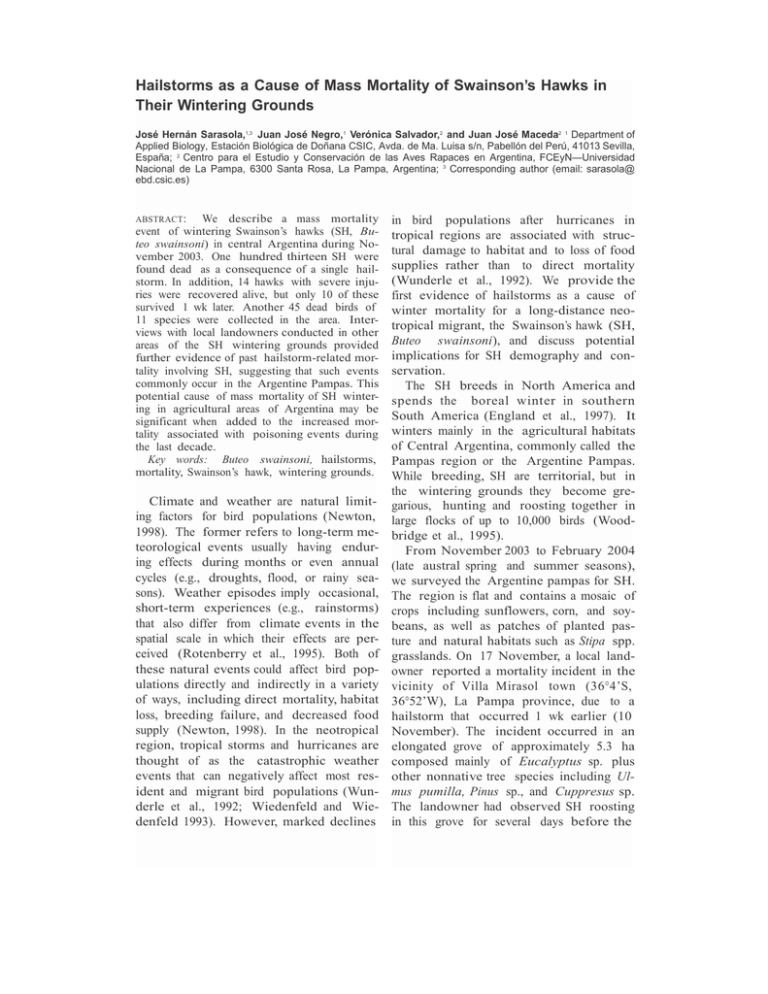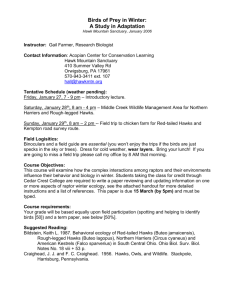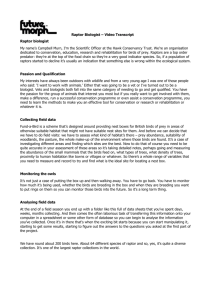hailstorms as a cause of mass mortality of swainson's hawks in their wintering grounds.doc
advertisement

Hailstorms as a Cause of Mass Mortality of Swainson’s Hawks in Their Wintering Grounds José Hernán Sarasola,1,3 Juan José Negro,1 Verónica Salvador,2 and Juan José Maceda2 1 Department of Applied Biology, Estación Biológica de Doñana CSIC, Avda. de Ma. Luisa s/n, Pabellón del Perú, 41013 Sevilla, España; 2 Centro para el Estudio y Conservación de las Aves Rapaces en Argentina, FCEyN—Universidad Nacional de La Pampa, 6300 Santa Rosa, La Pampa, Argentina; 3 Corresponding author (email: sarasola@ ebd.csic.es) ABSTRACT : We describe a mass mortality event of wintering Swainson’s hawks (SH, Buteo swainsoni) in central Argentina during November 2003. One hundred thirteen SH were found dead as a consequence of a single hailstorm. In addition, 14 hawks with severe injuries were recovered alive, but only 10 of these survived 1 wk later. Another 45 dead birds of 11 species were collected in the area. Interviews with local landowners conducted in other areas of the SH wintering grounds provided further evidence of past hailstorm-related mortality involving SH, suggesting that such events commonly occur in the Argentine Pampas. This potential cause of mass mortality of SH wintering in agricultural areas of Argentina may be significant when added to the increased mortality associated with poisoning events during the last decade. Key words: Buteo swainsoni, hailstorms, mortality, Swainson’s hawk, wintering grounds. Climate and weather are natural limiting factors for bird populations (Newton, 1998). The former refers to long-term meteorological events usually having enduring effects during months or even annual cycles (e.g., droughts, flood, or rainy seasons). Weather episodes imply occasional, short-term experiences (e.g., rainstorms) that also differ from climate events in the spatial scale in which their effects are perceived (Rotenberry et al., 1995). Both of these natural events could affect bird populations directly and indirectly in a variety of ways, including direct mortality, habitat loss, breeding failure, and decreased food supply (Newton, 1998). In the neotropical region, tropical storms and hurricanes are thought of as the catastrophic weather events that can negatively affect most resident and migrant bird populations (Wunderle et al., 1992; Wiedenfeld and Wiedenfeld 1993). However, marked declines in bird populations after hurricanes in tropical regions are associated with structural damage to habitat and to loss of food supplies rather than to direct mortality (Wunderle et al., 1992). We provide the first evidence of hailstorms as a cause of winter mortality for a long-distance neotropical migrant, the Swainson’s hawk (SH, Buteo swainsoni), and discuss potential implications for SH demography and conservation. The SH breeds in North America and spends the boreal winter in southern South America (England et al., 1997). It winters mainly in the agricultural habitats of Central Argentina, commonly called the Pampas region or the Argentine Pampas. While breeding, SH are territorial, but in the wintering grounds they become gregarious, hunting and roosting together in large flocks of up to 10,000 birds (Woodbridge et al., 1995). From November 2003 to February 2004 (late austral spring and summer seasons), we surveyed the Argentine pampas for SH. The region is flat and contains a mosaic of crops including sunflowers, corn, and soybeans, as well as patches of planted pasture and natural habitats such as Stipa spp. grasslands. On 17 November, a local landowner reported a mortality incident in the vicinity of Villa Mirasol town (36°4’S, 36°52’W), La Pampa province, due to a hailstorm that occurred 1 wk earlier (10 November). The incident occurred in an elongated grove of approximately 5.3 ha composed mainly of Eucalyptus sp. plus other nonnative tree species including Ulmus pumilla, Pinus sp., and Cuppresus sp. The landowner had observed SH roosting in this grove for several days before the TABLE 1. Summary of bird species and number of birds affected by a hailstorm recorded in northern La Pampa province, November 2003. Species Rufous hornero (Furnarius rufus) House sparrow (Passer domesticus) White-tailed kite (Elanus leucurus) Pigeons and dovesa Chimango caracara (Milvago chimango) Southern caracara (Caracara plancus)b American kestrel (Falco sparverius) Whistling heron (Syrigma sibilatrix) Monk parakeet (Myiopsitta monachus) Swainson’s hawk (Buteo swainsoni) Aplomado falcon (Falco femoralis) Campo flicker (Colaptes campestris) Total Number of birds 2 1 1 32 1 1 1 1 3 113 1 1 158 a Sample including two spot-winged pigeons (Columba maculosa), three Picazuro pigeons (C. picazuro), and two eared doves (Zenaida auriculata). The remaining birds were notidentified (see text for further details). b Juvenile. storm. Surrounding areas were plowed fields and perennial pastures. We searched the grove as well as adjacent fields for dead and injured birds. One hundred thirteen dead and 14 live SH were found under roost trees and in adjacent fields. In addition, 45 dead individuals of 11 different bird species were found (Table 1). None of them suffered the high mortality of the SH. Most of the dead and live SH were recovered under the trees in the roosting area but 12 hawk carcasses were collected in the surrounding field, all within 120 m of the roost. All dead individuals of other bird species were collected under the trees in the roost site. Because we were unable to complete the survey of the roost site and its adjacent area during 1 day of fieldwork, we counted and marked all the raptor’s carcasses found until sunset. The next day, 15 hr later, the number of carcasses was the same and there was no evidence of scavenging activity, indicating that at the time of our visit the estimation of the number of dead hawks and other raptor species may not have been affected by removal by scavengers. Plucked feathers of pigeons and doves were practically the only remains we found of those species, suggesting that scavengers preferred such small birds for feeding and that their total number of birds was probably underestimated. The hawks recovered alive had injuries and broken bones. Broken bones were mainly in the wings (three birds), skull (one bird), and tarsus (one bird), and injuries were observed in wings (three birds) and skull (one bird). Six of the SH had no evidence of injuries but were unable to fly. Only 10 of these recovered hawks survived for 1 wk. Trees in the grove had evidence of the impact of hailstones in their bark as well as defoliation and branch losses. On the basis of marks in the bark and from comments of the landowner, we estimated that the hailstones were approximately 7 cm in diameter, corresponding to a weight of 165 g (ice density 5 0.92 g cm3). A hailstone of this size and weight is large enough to kill large-sized birds like SH with an average body mass of 800 g (Goldstein et al., 1999; Sarasola et al., 2004). Neighboring groves located 2 km away had no evidence of the hailstorm. We estimated the age and gender of dead SH by using plumage characteristics (Wheeler and Clark, 1995) to identify juvenile-immature from adult birds and the length of the forewing as a discriminating variable among genders (Sarasola and Negro, 2004). From 90 carcasses inspected, the percentage of birds belonging to each age and sex group was 16% juvenile male, 38% adult male, 14% juvenile female, and 33% adult female. We did not necropsy each dead hawk to determine the causes of death. Previous reports of massive mortality of wintering populations of SH have been related to chemical poisoning with organophosphate compounds during the 1995–96 and 1996– 97 austral summers, with an estimate of 700 and 20,000 birds affected, respectively (Woodbridge et al., 1995; Goldstein et al., 1996). Nevertheless, field evidence as well as landowner remarks and the injuries ob- served in surviving birds confirmed that this mortality incident was the consequence of the hailstorm and was unrelated to insecticide poisoning. Birds of prey are rarely mentioned as suffering direct mortality by catastrophic weather events (Newton, 1978) and we are aware of only one report of raptor mortality caused by hail in which SH were among the affected species (Jones, 1952). Raptors may be better equipped than other birds to survive severe weather situations because of their relative large size and the ability to fast for long periods (Garcı́a-Rodrı́guez et al., 1987). They also need to devote a smaller proportion of their daily energy intake to maintain body temperature when ambient temperature declines because of their lower surface area to volume ratio, making them less vulnerable to hypothermia. Their dispersal capability and territorial behavior may explain why sporadic but severe weather events have little effect on their populations or may simply be too difficult to detect. Although communal roosting supposedly benefits individuals in terms of a reduction in thermoregulation demands, a decrease in predation risk (e.g., dilution), and an increase in foraging efficiency (Beauchamp, 1999), it may be catastrophic when there are weather-related causes of mortality such as hailstorms. Patchy distribution of suitable habitat (e.g., groves of alien tree species spread in agriculture lands), which results in large congregations of birds, may also increase the probability of mortality from such causes. Swainson’s hawks and other colonial raptors, such as the lesser kestrel (Falco naumanni; Negro, 1997), return to the roost site for shelter any time during the day before thunderstorms (Dehley and Scorolli, 1988); this behavior would enhance the probability of mortality in a whole flock if a severe hailstorm takes place. We found evidence of differential mortality when considering the number of dead birds for each of the raptor species and their relative abundance in the area. Only a few individuals of raptor species affected by the storm were seen flying in the area during roost inspection (two southern caracaras, two American kestrels, one aplomado falcon, and one white-tailed kite were recorded), whereas at least 20 chimango caracaras were observed during the grove survey and only one was found dead. Chimango caracaras are a raptor species well adapted to urban and periurban areas (Travaini et al., 1995) and this feature may have allowed them to avoid the impact of hail by finding refuge in human buildings near the grove. Swainson’s hawks were not seen near the grove during the field inspection, presumably because surviving hawks had moved to another area. Although we have no data on the number of SH roosting in the grove before the hailstorm, we suspect that the number of surviving SH was very low and that almost the entire flock was likely killed or injured by the hail. Rainstorms with high-speed winds may cause hawks to fall down from their perch while roosting (Goldstein, 1997), but direct mortality as a consequence of this kind of adverse weather condition has not been reported for wintering areas. We recorded further evidence of hawk mortality by hailstorms in Buenos Aires province by interviewing a local landowner. Several hundred SH were affected on that occasion, although accurate data on the year and the exact number of individuals was unknown. Furthermore, severe hailstorms producing ice stones > 2.5 cm in diameter are frequent in the Argentine Pampas. In some areas of La Pampa province, for example, a mean of 3.2 days during the austral summer season (December to March) are expected to have such storms (National Meteorological Service of Argentina, internal report). Consequences of mass mortality events, as reported here, may have a direct impact on local abundance of SH in breeding grounds, which will be more significant if hawks in wintering areas are seg- regated according to their breeding ground origin. We are indebted to Agustı́n Lanusse for giving useful information about the occurrence and localization of the mortality, and Adelmar Funk and Carlos Tucat (Zoo de America, America town, Buenos Aires province) for field assistance and care of surviving hawks. We thank Jorge Urruspuru and his family for logistic assistance during fieldwork. Financial support was provided by the Wildlife Conservation Society (USA) and Universidad Nacional de La Pampa (Argentina). While doing this research, J.H.S. was supported by a scholarship from Consejo Nacional de Investigaciones Cientı́ficas y Té cnicas de Argentina (CONICET) and Consejerı́a de Educació n y Ciencia de la Junta de Andalucı́a (Spain). We thank three anonymous reviewers for helpful comments that greatly improved this manuscript. LITERATURE CITED BEAUCHAMP, G. 1999. The evolution of communal roosting in birds: Origin and secondary losses. Behavioral Ecology 10: 675–687. DELHEY, R., AND A. SCOROLLI. 1988. El aguilucho langostero en el sur y sureste de Buenos Aires. Nuestras Aves 21: 29–30. ENGLAND, A. S., M. J. BECHARD, AND C. S. HOUSTON. 1997. Swainson’s Hawk (Buteo swainsoni). In The birds of North America, A. Poole and F. Gill (eds.), no. 265. Academy of Natural Sciences, Philadelphia, Pennsylvania, and The American Ornithologists Union, Washington, D.C. GARCı́A-RODRı́GUEZ, T., M. FERRER, J. C. CARRILLO, AND J. CASTROVIEJO. 1987. Metabolic responses of Buteo buteo to long-term fasting and refeeding. Comparative Biochemistry and Physiology A 87: 381–386. GOLDSTEIN, M. I. 1997. Toxicological assessment of a neotropical migrant on its non-breeding grounds: Case study of the Swainson’s Hawk in Argentina. MSc Dissertation, Clemson University, Clemson, South Carolina, 126 pp. , B. WOODBRIDGE, M. E. ZACCAGNINI, S. B. CANAVELLI, AND A. LANUSSE. 1996. An assess- ment of mortality of Swainson’s Hawks on wintering grounds in Argentina. Journal of Raptor Research 30: 106–107. , P. H. BLOOM, J. H. SARASOLA, AND T. E. LACHER. 1999. Post-migration weight gain of Swainson’s hawk on the wintering grounds in Argentina. Wilson Bulletin 111: 428–432. JONES, G. 1952. Hail damage to wildlife in southwest Oklahoma. Wilson Bulletin 64: 166–167. NEGRO, J. J. 1997. Lesser kestrel Falco naumanni. Birds of the Western Palearctic Update 1: 49– 53. NEWTON, I. 1978. Population ecology of raptors. T&AD Poyser, London, UK, 399 pp. . 1998. Population limitation in birds. Academic Press, San Diego, California, 597 pp. ROTENBERRY, J. T., R. J. COOPER, J. M. WUNDERLE, AND K. SMITH. 1995. When and how are populations limited? The roles of insect outbreaks, fire, and another natural perturbations. In Ecology and management of neotropical migratory birds, T. E. Martin and D. M. Finch (eds.). Oxford University Press, Oxford, UK, pp. 55–84. SARASOLA, J. H., AND J. J. NEGRO. 2004. Gender identification in the Swainson’s Hawk (Buteo swainsoni) using molecular procedures and discriminant function analysis. Journal of Raptor Research 38: 357–361. , J. J. NEGRO, AND A. TRAVAINI. 2004. Nutritional condition and serum biochemistry for freeliving Swainson’s Hawks wintering in central Argentina. Comparative Biochemistry and Physiology A 137: 697–701. TRAVAINI, A., A. RODRIGUEZ, O. CEBALLOS, J. A. DONAZAR, AND F. HIRALDO. 1995. Roadside raptor surveys in central Argentina. Hornero 14: 64–66. WHEELER, B. K., AND W. S. CLARK. 1995. A photographic guide to North American raptors. Academic Press, San Diego, California, 198 pp. WIEDENFELD, D. A., AND M. G. WIEDENFELD. 1993. Large kill of neotropical migrants by tornado and storm in Louisiana, April 1993. Journal of Field Ornithology 66: 70–80. WOODBRIDGE, B., K. K. FINLEY, AND S. T. SEAGER. 1995. An investigation of the Swainson’s Hawk in Argentina. Journal of Raptor Research 29: 202–204. WUNDERLE, J. M., D. J. LODGE, AND R. B. WAIDE. 1992. Short-term effects of the hurricane Gilbert on terrestrial bird populations on Jamaica. Auk 109: 148–166.



